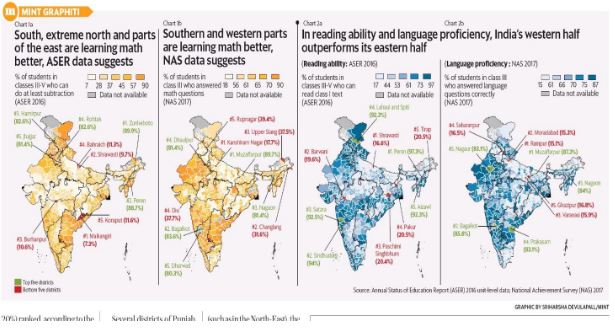ForumIAS announcing GS Foundation Program for UPSC CSE 2025-26 from 27th May. Click Here for more information.
The geography of learning outcomes in India
News
According to a recent analysis, there is significant geographic inequality in learning outcomes, with prosperous parts of India performing way better than poorer parts
Important Facts:
The analysis has been based on two datasets: Unit level data from the annual state of education report (ASER) 2016 and District level report cards published by the National Council of Educational Research and Training (NCERT) based on the results of the National Achievement Survey (NAS), 2017
Observations:
- According to both the surveys, large parts of Uttar Pradesh, Bihar, and Madhya Pradesh have the poorest learning outcomes in India. These parts are also the poorest parts suggesting that Indian school education system is failing to provide quality education particularly in those parts of the country where it is needed the most.
- Numeracy:
- Better performing districts are concentrated in Peninsular India, in the extreme north, and in a narrow strip along the east coast extending all the way to the North-East.
- It is important to note that there are differences in between ASER and NAS datasets. For example: NAS data suggests districts in Rajasthan is among the top performer in basic math. But the ASER numbers suggest that these districts are considerably worse than the national average.
- Language:
- South India performs the best in language scores (NAS) and reading ability (ASER).
- However, East India except pockets in the North East and West Bengal performs considerably worse than the western India in language proficiency and reading ability
Reasons for inequality in learning outcomes:
- The trends in learning outcomes are also nearly similar to the trends in affluence where districts in Western India perform better than those in Eastern India. This is because the affluent and the privileged tend to learn better.
- Low level of investments in school infrastructure and weak monitoring in the poorer districts





